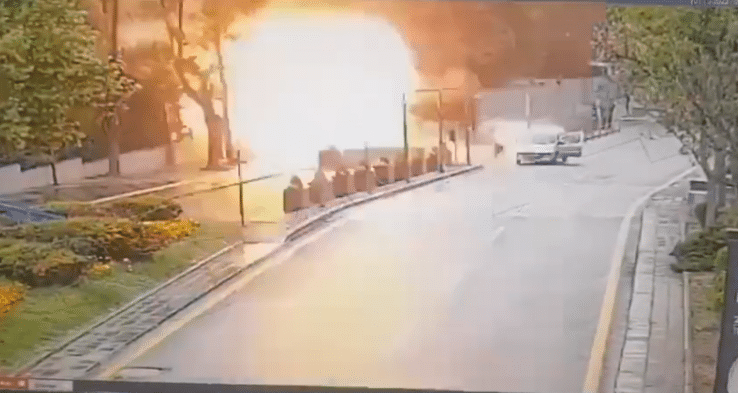On the morning of 1 October, two PKK-linked fighters launched an attack outside of Turkey’s Ministry of Interior building in Ankara. The perpetrators reportedly used small arms and an explosive vest during the attack which resulted in the death of two of the attackers and injuries to two police officers. In response to the incident, Turkish military forces conducted retaliatory strikes in northern Iraq within 12 hours of the attack in Ankara, destroying a number of PKK-linked locations across areas of northern Erbil, Duhok, and Sulaymaniyah provinces.
The incident on 1 October will understandably set conditions for a further intensification in Turkish cross-border activity over the short-to-medium term, and the attack will serve as justification for the government’s hardline approach against the militant group. This will likely include a continuation of Turkish UAV-and airstrike activity in northern Iraq and northeastern Syria, as well as an intensification of measures against Kurdish political movements inside Turkey.
PKK claims responsibility for attack in Ankara
On 1 October, at around 09:30, two PKK-linked fighters carried out an attack outside of Turkey’s Ministry of Interior, resulting in the deaths of the two attackers and injuries to two police officers. The Ministry of Interior announced that one of the assailants detonated a suicide vest during an engagement with security forces deployed outside the building while the second was “neutralized” before he was able to detonate his device. CCTV-footage from the incident depicted both assailants arriving in a civilian vehicle, with one armed with an automatic rifle approaching the main entrance and detonating his vest just outside a guard post. The second assailant was then shot and killed in the subsequent engagement. A shoulder-fired rocket launcher, explosives and hand grenades were also reportedly found during a subsequent inspection of the vehicle.
The People’s Defence Forces (HPG), which is the military wing of the PKK, confirmed responsibility for the attack in a statement that commemorated the two as martyrs for their cause, identifying them as Rojhat Zilan and Erdal Şahin. The statement justified the attack as an “act of self-defense against oppression, destruction of Kurdistan’s nature, and pressure on the people of Kurdistan” while claiming that “the attack successfully achieved its goal by eliminating the intended target.” The Turkish Ministry of Interior also announced that one of the assailants was identified as a member of the PKK while efforts were underway to identify the second attacker. According to the Interior Ministry statement, the attackers arrived in a vehicle that was seized in the Kayseri province. The owner of the vehicle, a veterinarian, was reportedly shot and killed during the carjacking, and his body was left on the side of the road before the assailants drove approximately 300 kilometers to the capital.
PKK sources condemned the Turkish government for providing inaccurate details related to the incident, claiming that the attack resulted in more casualties than the Turkish government’s reported injuries to two police officers. This however is not immediately clear from the footage where few, if any, individuals are seen in proximity to the detonation.
Turkey conducts retaliatory strikes in northern Erbil, Duhok, and Sulaymaniyah provinces
Approximately 12 hours after the attack in Ankara, at around 21:30, multiple sources reported that Turkish military aircraft were striking a variety of locations across northern Erbil and Duhok provinces, with low-flying aircraft and nearby explosions causing panic amongst local populations. The Turkish Ministry of Defense confirmed the operation, claiming that Turkish aircraft targeted “terrorists in the Metina, Hakurk, Qandil, and Gara regions of northern Iraq” and that the airstrikes “destroyed 20 targets, including caves, bunkers, shelters, and warehouses utilized by the terrorist organization.” Local officials also discussed the attacks, noting that shortly before the airstrikes, residents noticed aircraft overhead. View the Talos Dashboard for specific locations targeted by the Turkish military during the evening’s strikes.
Officials have not yet confirmed the resulting casualty figures, and the extent of damages claimed by the Turkish Ministry of Defense, which reportedly included a variety of targets, have not been verified or further confirmed. It is possible that the Turkish Ministry of Defense will release aerial footage of the operation for propaganda purposes, which may provide additional clarification. Further strikes should not be ruled out as Turkey seeks to exact a cost on the PKK, re-establish deterrence, and demonstrate resolve and justice for domestic audiences.
Attack follows intensification in Turkish operations
The attack on 1 October took place only hours before President Recep Tayyip Erdogan was scheduled to inaugurate the first session of the Turkish parliament after a three-month summer recess. The site of the attack is located in close proximity to the General Assembly as well as other government ministries, with the timing and location of the incident clearly intended as an attack on the Turkish political establishment. The operation is the first significant terrorist attack inside Turkey since an IED attack in Istanbul on 13 November 2022 when six people were killed and 81 were injured. Turkish officials blamed the incident on the PKK/YPG however, unlike the 1 October operation, the attack was never claimed by the group.
The latest operation follows a period of heightened Turkish operations against the PKK in northern Iraq and Syria, and in particular, an escalation in air and UAV strikes targeting PKK elements in the Sulaymaniyah province. This includes most notably a strike on the Arbat Agricultural Airport on 18 September when three members of the Sulaymaniyah-based Counter-Terrorism Directorate were killed. The strike formed part of an ongoing Turkey-led pressure campaign on the PUK to sever its alleged ties with the PKK and the Turkish Ministry of Defence later claimed that PKK elements were present at the time of the incident.
More broadly, the intensification observed coincided with the re-election of President Erdogan in June which was followed by a significant statistical increase in airstrike activity inside traditional areas of operations in northern Duhok and Erbil province, but also outside of these areas. Beyond Sulaymaniyah, this includes attacks in Sinjar district of Nineveh province where another UAV strike recently targeted and killed three members of the YBS on 17 September. Similar dynamics have been observed in northern Syria where the Syrian Democratic Forces over the summer warned of an intensification in Turkish airstrike activity as well as in operations conducted by Turkish-backed forces.
Conditions set for increase in Turkey’s anti-PKK campaign in Turkey, Iraq, and Syria
The incident on 1 October will understandably set conditions for a further intensification in Turkish cross-border activity over the short-to-medium term, and the attack will serve as justification for the government’s hardline approach against the militant group. In his speech to parliament hours after the attack, President Erdogan reiterated the government’s intent to create a buffer zone extending approximately 30 kilometers along the border with Syria. In a statement on X/Twitter, the president also declared that “our fight against terrorism will continue with more determination.”
In Iraq, these pledges will likely involve a continuation of ground operations and airstrike activity within the Operation Claw-Lock Sector of Duhok province until a seasonal decline is expected as weather conditions change. An expansion of current areas of operations is also plausible as Turkey may opt to boost its operational presence in the Amedi district and other areas associated with PKK presence. A continuation of out-of-area precision strikes targeting PKK-linked individuals and sites in Sulaymaniyah province, Sinjar district, and possibly near Makhmour is also likely, with client operations to remain aware of the potential for collateral damages.
In Syria, Turkey may likewise intensify precision strikes against YPG-linked elements while likely opting to increase border security and its support for Turkish-backed Free Syrian Army elements. Turkey may also attempt to exploit the ongoing unrest between the SDF and Deir Ez Zour Military Council to undermine the SDF/YPG, with present conditions increasing the risk of clashes between Turkish-backed elements and the Kurdish-dominated forces. Domestically, the incident also sets conditions for intensification in the government’s perceived targeting of Kurdish factions, including the People’s Democratic Party (HPD), with arrests of party officials and measures intended to marginalize the movement set to increase on a provincial and local administrative level.


